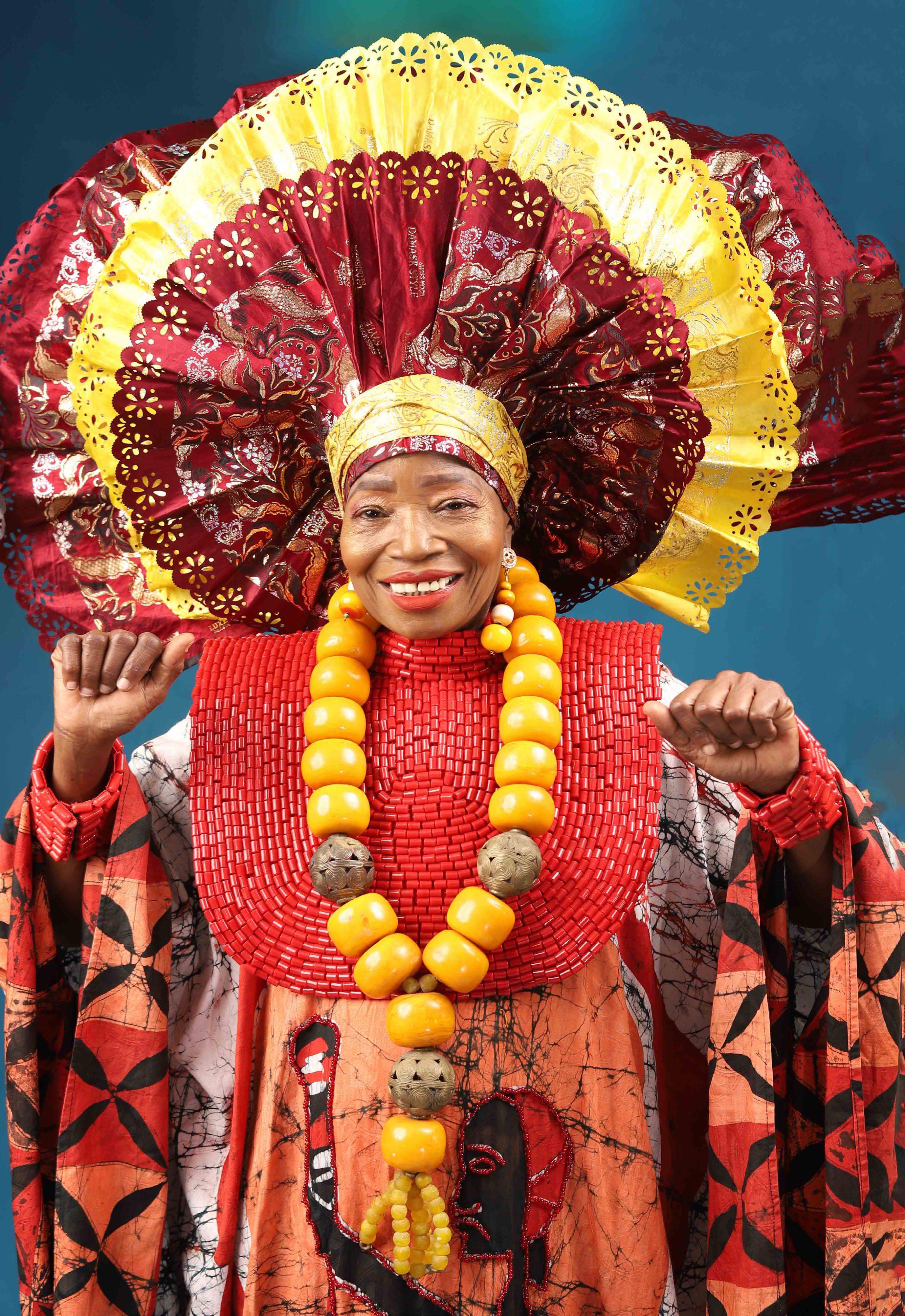

It took a few days to finally secure a meeting with Chiefs Nike and Reuben Okundaye, and it was well worth the wait. Our conversation centred on culture, art, and heritage had me thinking about the many cultures we have lost as a country with many states. While I agree that the new generation barely knows a lot about our culture, especially with respect, a few people have chosen to avoid following the route of the oyibos and teach their kids the many traditions and cultures of our exceptionally vibrant nation.
One such person whose name I will withhold, I admire that she instils certain values in her sons. She has kept their Yoruba culture of the boys prostrating when they greet her or even strangers(guests). So strong are those values of their culture in their home that even the family pet pug knows to dobale when he sees her in the morning. Now, that’s what I’m talking about.
My conversation with our cover personality and her husband covers diverse topics, including heritage.
You all remember the stolen artefacts that were returned, right? We spoke about that too, and while Mama Nike and I were on the same side, Daddy Reuben believes it’s obnoxious to think we need people teaching us how to care for our own creations. Many lessons that should have been passed from generation to generation stopped at a particular era, so do we still have the know-how to care for these artefacts?
I am a product of a generation that lost some knowledge that could have been passed down to me, and not a day goes by that I do not kick myself asking why I didn’t learn about herbs from my grandmother. She was so good that she could pick the right plants for couples who couldn’t have a baby. All that knowledge is buried with her, and so it makes me wonder and, at the same time, hope that we do not lose the artefacts.
Don’t get me wrong. I am not saying they shouldn’t be home to Nigeria. I’m wondering if previous generations passed on the know-how to preserve them.


Until next week, enjoy your read.
AUSTYN OGANNAH PUBLISHER/EDITOR-IN-CHIEF
Editor: Onah Nwachukwu @onahluciaa

Editor-at-Large: Chalya Shagaya
Writer: Kehindé Fagbule

Graphic Design: Oludemilade Aremu


Digital Media: Oladimeji Balogun

Guest Art Director: Sunny Hughes ‘ SunZA’
Dorcas Akintoye
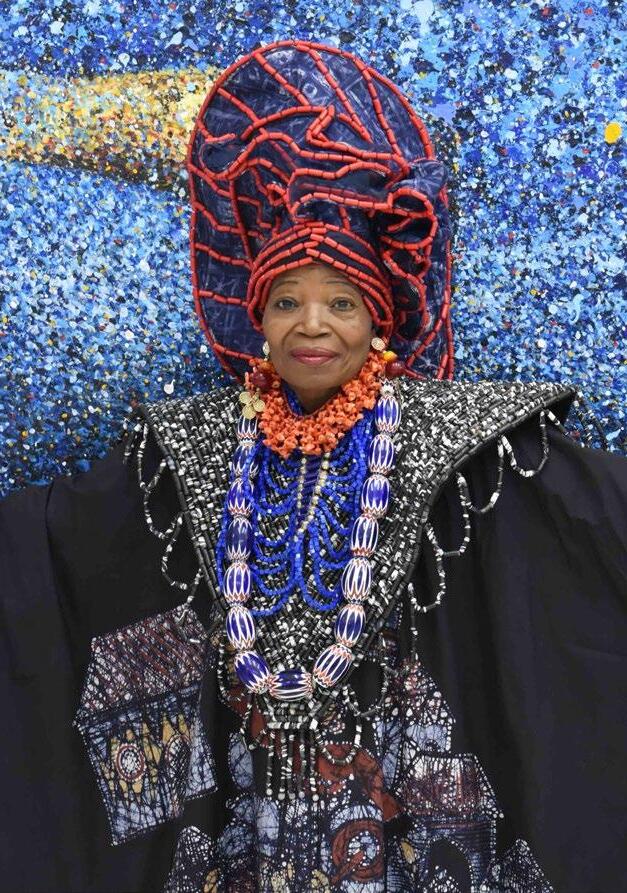


Dorcas Akintoye is a dedicated writer with more than 2 years prolific experience in writing articles ranging from food, entertainment, fashion and beauty. She has a National Diploma in Mass Communication from Kwara State Polytechnic, Ilorin. She loves writing, listening to music and playing scrabble. She is a highly-skilled, enthusiastic, selfmotivated professional writer.
Onwumere Churchill Ikenna

- Contributing Writer




Onwumere Churchill Ikenna is a writer, poet, digital and social media content strategist. An Afro gen z clan member of kenga media. He is a movie critic who was amongst those who birthed the first movie brand; Feeem house brand. A full fledged member of the writers space Africa, Nigeria district and was part of the editing team of the second anthology issue by the writers space Nigeria.
He has written so many articles, stories and e books. An avid reader and a freelancer. You can check out his literary editing page @coidencreatives on Instagram and twitter.
His personal socials for both Instagram and twitter are : @ikennachurchill



Satisfying

VOL 3 NO. 15 • APRIL 09 - APRIL 15, 2023 PAGE 2 THEWILL DOWNTOWN • www.thewilldowntown.com www.thewilldowntown.com thewilldowntown thewilldowntown @onahluciaa + 2349088352246 Onah Odun Ogunbiyi @oddbodandthecity - Contributing Editor Odunayo Ogunbiyi is an ex pharmacist with a passion for food and pampering. Writing about her exploits wherever in the world she may find herself is just her way of staying sane in this zany world. Boluwatife Adesina @bolugramm - Contributing Writer Boluwatife Adesina is a media writer and the helmer of the Downtown Review page. He’s probably in a cinema near you. Photo: Kola Oshalusi @insignamedia Makeup: Zaron CONTENTS 5 Easter Movies to Watch With The Entire Family 06 8-10 16 12-13 14-15 11 REVIEW WELLNESS BON APPÉTIT BEAUTY CAREER COVER Daycare is Healthcare: Creche in The Workplace is a Non-negotiable Talking Art, Culture And Heritage With Nike & Reuben Okundaye Join The Ayurvedic Bandwagon Eggciting Easter: 10 Ways You Can Enjoy Your Easter Eggs Easter Beauty Egg EDITOR’S NOTE 07 04-05 FASHION The Evolution: How Technology Has Helped Gen Z In Fashion Byline: Churchill DOWNTOWN CONFIDENTIAL Common Relationship Issues And How To Solve Them
WHAT YOU SAID @lisafolawiyo @skehinah_lems INSTAGRAM
to read this is hilarious @oddbod&thecity

PAGE 3 THEWILL DOWNTOWN • www.thewilldowntown.com VOL 3 NO. 15 • APRIL 09 - APRIL 15, 2023
The Evolution
HOW TECHNOLOGY HAS HELPED Gen Z In Fashion
 BY ONWUMERE IKENNA CHURCHILL
BY ONWUMERE IKENNA CHURCHILL
There is an appetite for fashion learning online. YouTube, a product of technology, has helped many designers learn a thing or two in the fashion industry. All you need is to set a strategy, birth your concepts and ideas, work with creative fashion designers, and master the craft, and you are set to go. And for your information, the electrical sewing machine and other machines needed for creating designer outfits are made out of technology; just like the car you have and use.

FASHION
VOL 3 NO. 15 • APRIL 09 - APRIL 15, 2023 THEWILL DOWNTOWN • www.thewilldowntown.com
brands


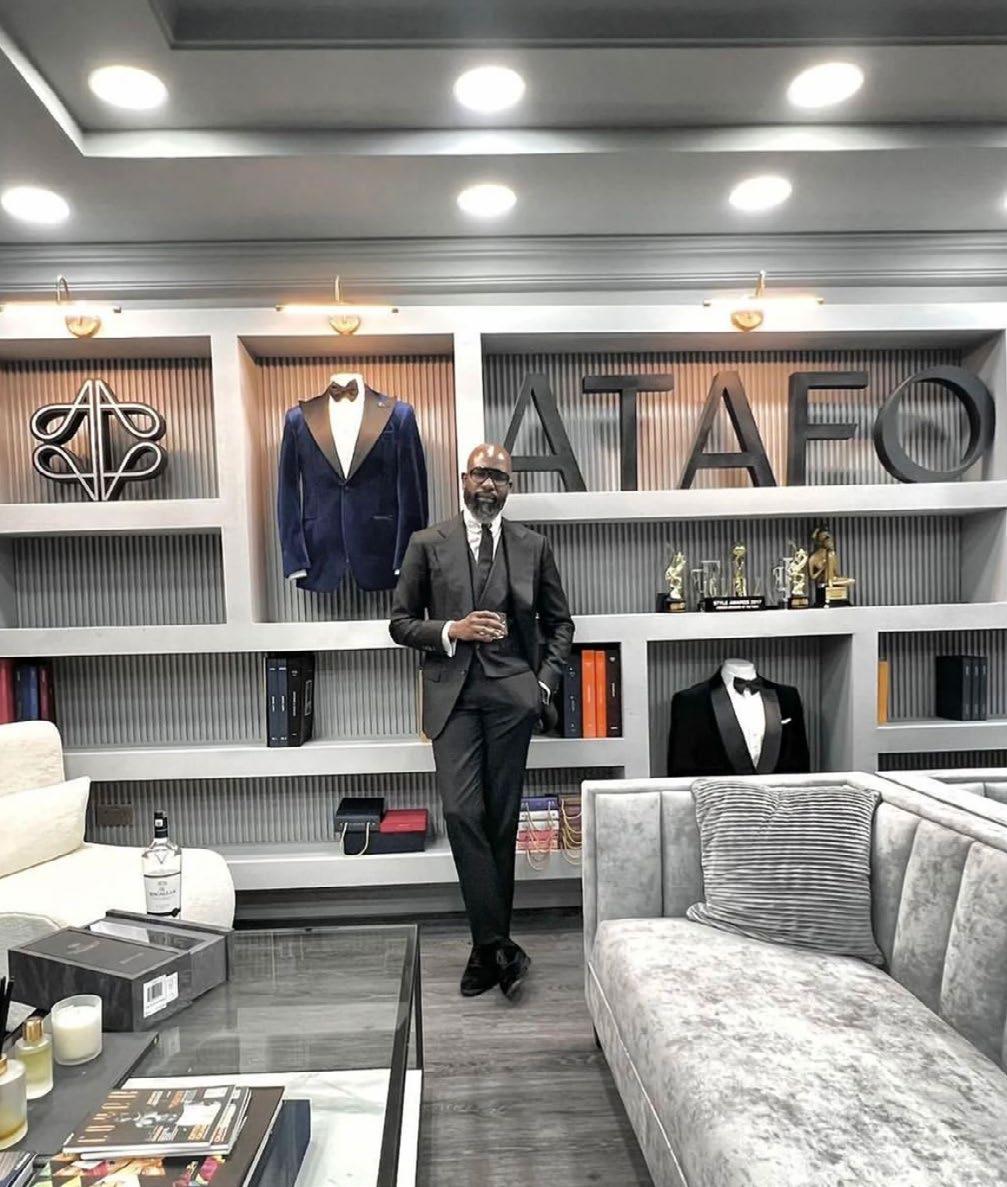
solutions as part of their design workflow. different kinds in the industry. All it needs

FASHION


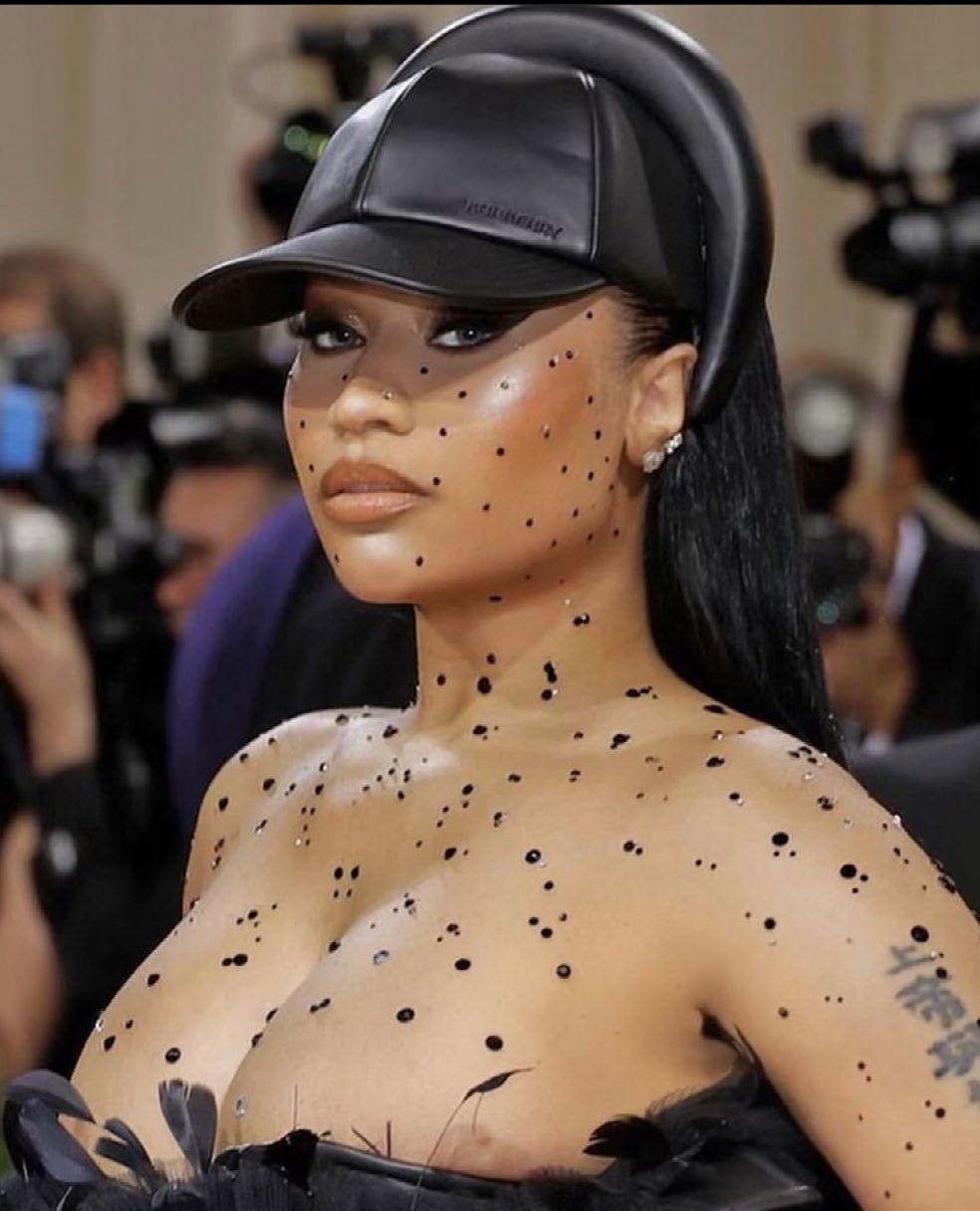
VOL 3 NO. 15 • APRIL 09 - APRIL 15, 2023
3D and AR experiences allow fashion
to connect with global audiences,
CRECHE IN THE WORKPLACE IS A NON-NEGOTIABLE Daycare is Healthcare
 BY KEHINDÉ FAGBULE
BY KEHINDÉ FAGBULE
Veryfew things in life are more important than our career. For every individual on earth, a common goal in this capitalistic world we live in will be to work as diligently as possible to earn as much to, in turn, lead a life with no financial constraints. Well, depending on who we are, life puts us on two usually very separate trajectories because, for most women, that whole experience is different. As soon as pregnancy is introduced, which is the case for many women, workplace modus operandi changes. And this is one of the leading causes of the gender pay gap to date—maternity is not something men have had to worry about. The substantial man-hours (for lack of a better word as ‘woman-hour’ is not a thing) women have to give up—between 10 to 12 weeks—already puts them at a disadvantage in the instances where they are directly competing against men for career advancement. So women have to work twice as hard trying to maintain a work-life balance that will leave both parts of their life unscathed. At some point, most of them have to leave their infants in someone else’s care as they resume back at the office, a tradition that is not only scary for the nursing mothers involved but also terrifying for whoever is responsible for keeping the infants alive in the meantime.
A much simpler resolution to this unnecessary loop is to keep nursing working-class mums closer to their babies, one would think. Crèches in offices have been the subject of gender conversations for as long as the number of women in the corporate world experience a progressive upturn.
Now, this is not a conversation that stays around 365 days a year, and for obvious reasons. The public discourse of due diligence and intentional support of women is not exactly popular in society until a tragedy grabs everyone’s attention. Oftentimes we hear stories of infant casualties in daycare establishments. And in most cases, the mother is off at work because her source of livelihood must be preserved. Surely asking for daycare facilities in the workplace is not that much of a crazy idea as it would curtail these accidents.
In 2021, the House of Representatives passed, for second reading, a bill seeking the establishment of crèche in government-owned and private offices, schools, hospitals and other workplaces. That proposal, sponsored by a member, Sergius Ogun, was contained in a bill seeking to amend the Labour Act. In his
argument, he quoted the Minister for Health, Prof Osagie Ehanire, in his press statement during the 2021 Breastfeeding Week, as noting that the exclusive breastfeeding rate in Nigeria was as low as 29 percent, indicating that 71 percent of infants in Nigeria do not enjoy the full benefits of breast milk in their formative years. Ehanire would eventually claim that many infants do not receive optimal feeding as only 9 percent of organisations in Nigeria have a workplace breastfeeding policy. That is a staggeringly low number, and what is to say it has improved since then? There has been neither further reading of nor the passing of the creche bill into law.
Women already have a lot on their plates throughout the natal experience, with a pretty significant number of them handed postpartum depression as a cruel aftermath—research conducted by the Centre for Disease Control and Prevention (CDC) reveals that postpartum depression affects 17.22 percent of the world’s population with 18.4 percent specific to the African continent and over 1.5 million prevalence in Nigeria yearly. It definitely is time for nature to stretch a mightily helping hand to nursing mothers, a workplace creche at a time.
VOL 3 NO. 15 • APRIL 09 - APRIL 15, 2023 PAGE 6 THEWILL DOWNTOWN • www.thewilldowntown.com CAREER
COMMON RELATIONSHIP ISSUES AND HOW TO SOLVE THEM

Relationship issues are problems or conflicts we can’t seem to avoid, no matter how hard we try. We have different types of relationships, including romantic relationships, family relationships, friendships, and even work relationships, and relationship issues are bound to happen in any of them. The most important thing is how we find solutions to them. We all agree that relationship issues can be hard to deal with, especially in romantic relationships. Still, at the same time, you must address them to maintain a healthy and satisfying relationship. Sometimes, to solve these issues, you must be able to give up some things, be willing to compromise and, most importantly, have a strong commitment to working through the problems with your partner.
(1) COMMUNICATION ISSUES
For any relationship to be successful, there is a need for you both to be able to communicate effectively. If you and your partner are having issues communicating effectively, one sure way to help the situation is by being more open with each other. Practice active listening and understand your partner’s perspective before responding to them.
(4) CONFLICT RESOLUTION ISSUES
As we’ve said earlier, no matter how hard you try, issues will always show up; it is typical for every relationship to have its fair share of conflicts. These are more reasons you need to develop healthy conflictresolution skills to help you resolve disagreements effectively. Always listen actively, speak honestly and respectfully, and, most importantly, be willing to compromise.
No matter the kind of relationship you are in, trust is an essential element. There are many ways to build trust in each other; setting boundaries and being more transparent are sure ways to solve trust issues. If you or your partner have trust issues, it will be advisable to seek the help of a therapist or counsellor.
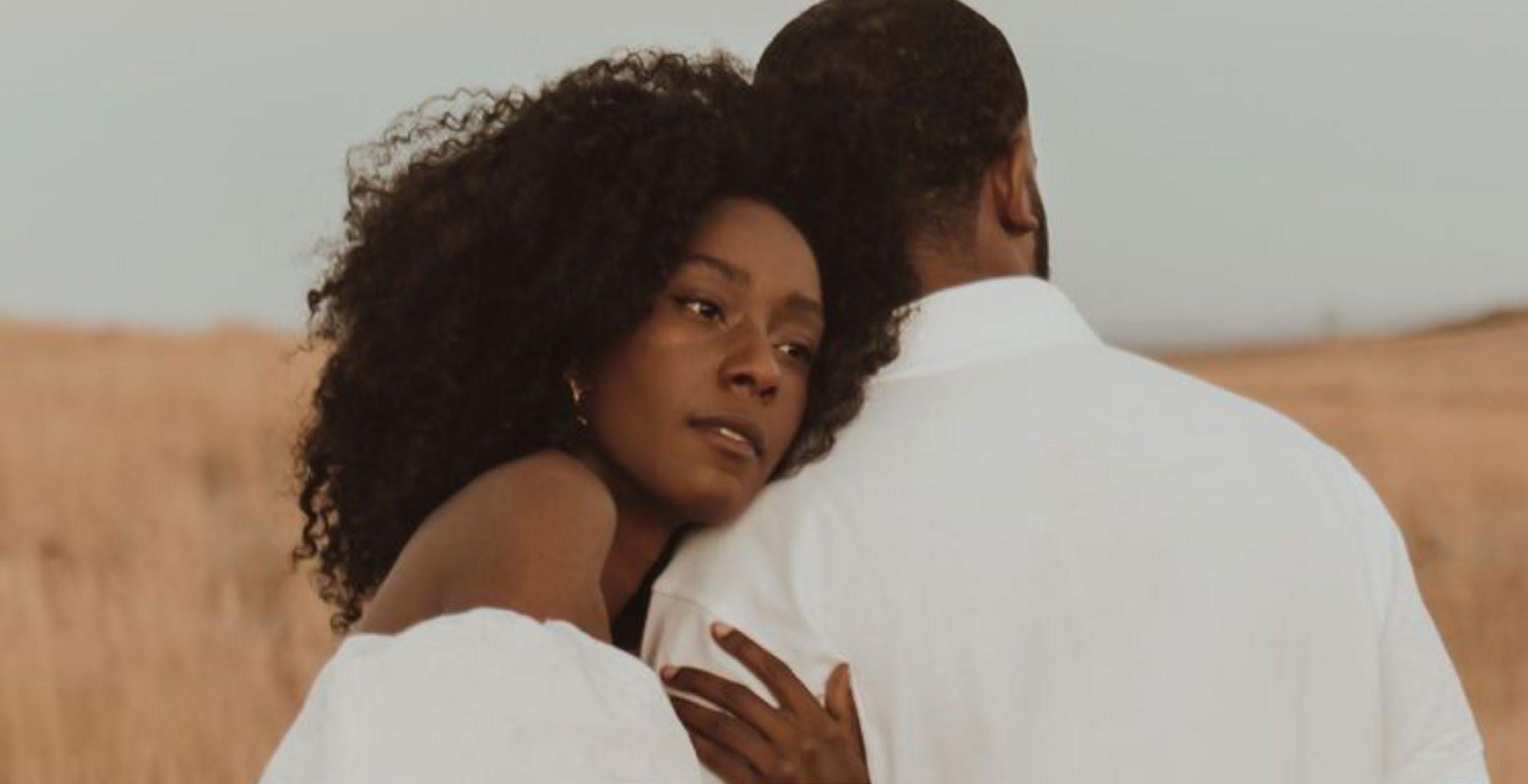
(5) DIFFERENT INTERESTS OR LIFESTYLES
It is normal for couples to have different interests or lifestyles. At the same time, you need to find ways to compromise and find common ground. Endeavour to learn about your partner’s interests and hobbies, don’t just learn them alone; try to participate in them together.

Key Takeaway
Every relationship is unique, and what works for couple A might not work for couple B. The key to resolving typical relationship issues is to communicate openly and honestly with your partner, be willing to compromise and seek help outside if needed.

(3) FINANCIAL ISSUES
To avoid having financial issues in your relationship, you should be more open and honest about your finances with your partner. Another way to do it is to set financial goals together and plan how to manage your finances as a team.

(6)
LACK OF INTIMACY
Intimacy is a crucial component in any healthy relationship. If you and your partner are having issues in this area, you must find ways to solve them before they get out of hand. One sure way to do it is by having an open and honest conversation. Another way to solve it is by identifying any underlying issues that may be contributing to the lack of intimacy between you and working together to find solutions.
(7) TIME MANAGEMENT ISSUES
It is normal for you and your partner to have busy schedules, making it difficult to spend quality time together. The best solution in that situation is for you both to prioritise your relationship by scheduling regular date nights or quality time together.
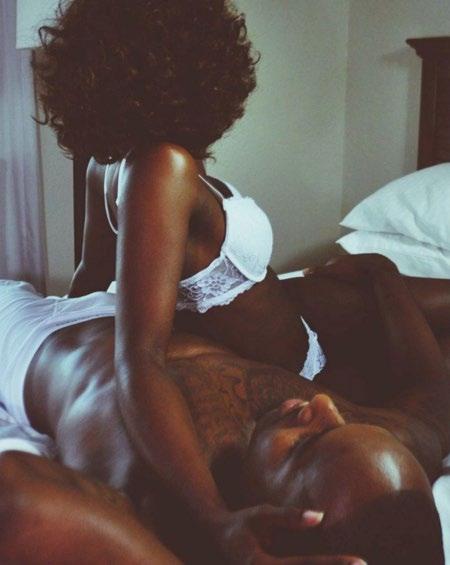

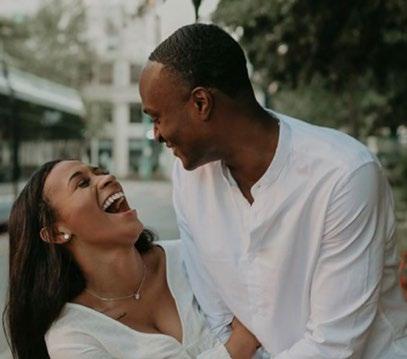
PAGE 7 THEWILL DOWNTOWN • www.thewilldowntown.com VOL 3 NO. 15 • APRIL 09 - APRIL 15, 2023 DOWNTOWN CONFIDENTIAL
(2) TRUST ISSUES
Aftera country’s name, its cultural identity is its most significant descriptive marker. Our culture, in its entirety, can be traced back to the time before westernisation conditioned the entire global population to dance to the colonial tune of yesteryears, ascribing a definition to civilisation that looks nothing like what our forefathers knew. Culture is the way of life that announces our ‘Nigerian-ness’ even before our oppressors christened us. However, for generations, we have steadily drifted from our culture as we know it.
This issue, an ongoing dilemma, was the topic of discussion when DOWNTOWN’s Editor, Onah Nwachukwu, sat with two of the most influential custodians of the Nigerian culture alive today in the Owner and Curator of the Nike Art Galleries in Osogbo, Lagos, Ogidi-Ijumu (Kogi State) and Abuja, Chief Mrs Nike Monica Okundaye, popularly referred to as “Mama Nike,” thanks to her lifelong philanthropy empowering women across the world, and her husband, Ex-Police commissioner, Reuben Osaruyi Okundaye. The couple talked about art as our biggest cultural heritage, its preservation and representation in fashion, and the manipulation of our ancestral religions by our colonial masters who were on a mission to whitewash our land and strip it of its resources and cultural blessings.
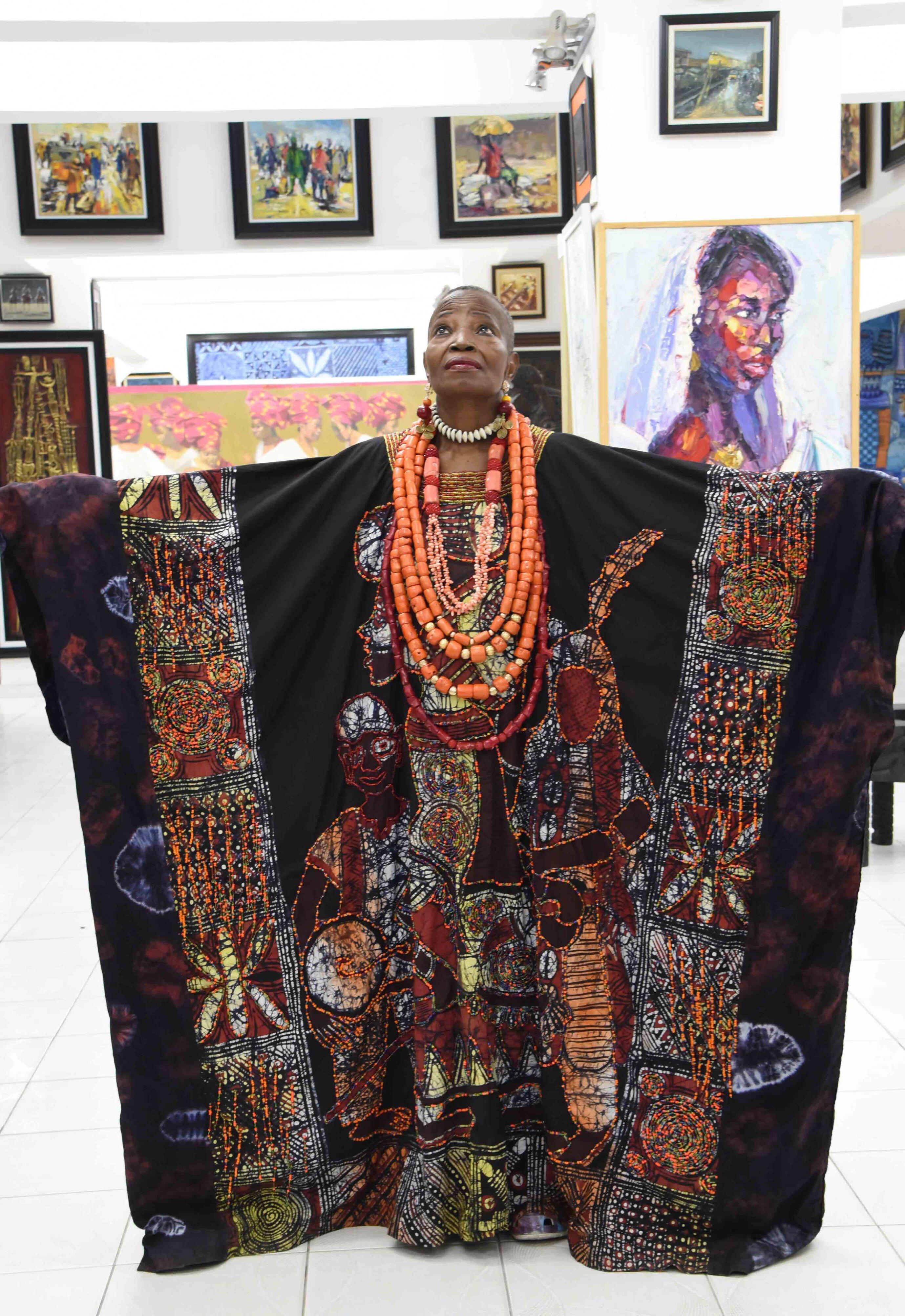
TALKING ART, CULTURE AND HERITAGE
WITH NIKE & REUBEN
E NDAY OKU
COVER
PAGE 8
Asa renowned exhibitor of African cultural art, what is culture to you?
Nike: Culture is our heritage. It is part of life. Growing up, you will follow your parents and their culture, the way they eat, dance, talk, and even proverbs, everything is part of our culture, and we must always adore it. After a country’s name, the next important thing is its culture. We should love and cherish our culture.
Reuben: It is what our forefathers have done in the past to move the country forward. How people acted and behaved in the past, and have been passed over from generation to generation, is our culture. This includes all activities of life, the way you sing, dance, play, do marriages, and celebrate birth and death; they all centre on our culture. Then if you go further to ask about our heritage, it is carried beyond what we are repeating, even to date, and trying to amplify what our forefathers had done in the past. Heritage and culture are interwoven.
How do you think we can preserve our culture because it looks like we are losing it?
To preserve our culture, we must continue training people who can take over after us. That is training the generation. Sometimes it may not even be your child, biological or adopted, but if you see someone you can train, then train them. It’s training the trainers because if you train somebody, they can train another person...
Nike
Nike: To preserve our culture, we must continue training people who can take over after us. That is training the generation. Sometimes it may not even be your child, biological or adopted, but if you see someone you can train, then train them. It’s training the trainers because if you train somebody, they can train another person. The only way is to keep passing the knowledge of our culture to our children so we will not lose everything in the future because, as it is now, we are losing everything. In those days, they would tell you not to sit on the mortar because they didn’t want you to fart inside it. When you’re eating, they would say, “Don’t stay by the door,” because if someone is passing by, they don’t drop sand in your food. If you are eating, don’t talk. That is because the food could go to your head or nose, and the person can die from it. There are many things that people are doing now that aren’t in our culture. When they go out to eat nowadays, they go there to talk. We don’t talk because we eat pepper; foreigners talk over meals because they don’t eat pepper. The food is different, cold food is different from hot food, and that is also culture, the way we eat.
Let’s talk about culture and fashion. What do you think our designers can do to preserve culture through their design while selling it?
Nike: They can preserve and sell our culture through their design by using symbols—those old symbols that people communicate with. Like when Fela said water has no enemy, there is a design from the textile that is called water. So that design is telling you, ‘I’m like water; I’m not your enemy.’ Then we have a design that is called ‘the presence of God in my life.’ There are a lot of symbols that fashion designers can use and also, and they can go back to the natural colours which are dying off. Look at our hair; now, people are sitting under the dryer. The first time I wanted an afro, I went under the dryer and fainted. I was there for three hours; my brain was cooking. In those days, you will braid your hair naturally, wash and comb it, and receive joy. The comb as a symbol means the road is open, the joy is accepted. Even geckos that people chase to kill help with ridding your house of little flies and spiders which could be poisonous. These are also part of our symbols. There is a design in Lagos called the goddess of the Sea. It consists of twenty-eight symbols; the umbrella, my head is correct, etc. These symbols can be placed on garments and put on the runway. There are so many things that we are destroying ourselves (that could have been used for fashion designs). Look at cotton, 100 percent cotton.
Northern Nigeria used to export cotton before, but now we import it. The same thing happened with palm oil. Our molue (long commercial buses) are now going extinct. We have to print them on the adire for our children to see. Our coins, which we no longer spend, we put in the gallery so people can see them. All those are gone, but we can still continue with the model because technology has changed everything. We are happy that we have social media now. In our own time, when we were going to school, we were only using pencils, not even biro. But now, children are using computers. That is why we need the youths; we need them more. But we still have to pass on this knowledge to them and say this is your culture. You can use it as a designer. Look at this head tie I’m wearing; it’s called auto-gele. I went to do it in Tejuosho to show the women. When you train a group of women, you train the nation. So now, people are not paying five thousand Naira to do the same gele anymore. Then we have the autogele, which you can just wear on the go. Before now, you had to spend three hours wearing the gele and having headaches because of it. And gele is supposed to be like a hat that brings you joy. Professor Wole Soyinka once wrote a book he titled Gele Gala, and made me the first lady of gele. It makes me happy whenever I see it.
You talked about the goddess of the sea as a god. Some people will argue that we should distance ourselves from such gods. Some argue that they are not bad but a part of our culture. Do you think that it was the white people who came and made us see them as bad? What do you think?
Nike: When the white people came, they said we should throw our religion away so we could embrace Christianity. But this new pope is telling people to embrace their culture. So there is a story with Pope Francis. They saw my work at the Vatican and asked me to return to our source and tell the story of how the Osun goddess gave people babies and whatever they wanted. It’s just like going to church and making a testimony. In the same way, people make pledges and say, “Osun, if you can do this for me, I will come back and do that for you.” They are not using human beings for worshipping. But our people, because they only go one way, immediately hear idol, and everything you do is an idol, even creativity. If you carve wood, they will say it is an idol. So they have to come back to their senses and see that we used our hands to create all this work. Cowries are frowned upon today as people identify it as an idol element, forgetting that we used to spend it as money back in the day. Or how they look at you differently when you go to Osun when it is the same as going to the beach.
Reuben: A community that has no culture or heritage is not a community. That community does not exist. It is highly regrettable that we have given away our own religion to our conquerors who came here, conquered us, ruled over us and enslaved us. They killed our own way of worship. We had always worshipped our gods before the white men came in. For those gods to be called satanic and fetish is one of the highest forms of wickedness that has been perpetrated on our people. Christianity and Islam are quite alien to us. But our foreign masters came in and told us that we should not serve our god but theirs. Neither Jesus Christ nor Muhammad was Nigerian nor African, but most unfortunately, our foreign masters came and ordered us to dump our own means of worship and started calling it all kinds of bad names. If you want to kill a dog, give the dog a bad name. That is what they did to us, and it is still one of the major problems that we have in this country.
They taught us to hate and see ourselves as different tribes and religions. If you decide to still believe in what our foreign masters asked us to do and not chart a course of our own, it is most unfortunate. I remember when India was granted independence, years before us, Gandhi told all Indians to dump the English language and religion. He told them not to write in English, and they developed their own character, stuck to Hindi, and practised their religion, which they still practice today. India is very well advanced; I think they have the biggest democracy in the world today with a population of one point something billion. In everything in life, they are doing very well. People would leave here for India to seek medical help. It is most unfortunate. When I’m looking back and relating all this, it reminds me of what our forefathers went through. The bitterness in their heart comes back to me, which is most unfortunate. Regarding training women, do you have a foundation or an organisation?
Nike: It is something I do by myself. So I started the training in 196; I was born into poverty. I lost my mother when I was seven before I got to primary six, and I saw how women suffer. Because of five Kobo, they could be beating themselves, and one man would marry maybe 20 of us and use our intelligence to say, “Oh, they have nowhere to go; let’s put them as workers in the house.” So when I came back, I was given the opportunity to travel to the US. But before then, I started the centre because my former husband had 15 wives and every time, we fight because of 1 or 2 Kobo, for what? So I decided to train them. If this handwoven skill can take me to America, it can also carry you. That was how I started the training and decided to share my knowledge with my colleagues. So I went to the garage to reach out to the girls hawking there because, in those days, that was where girls were raped, had early pregnancies and were rejected. I started the Training The Trainer initiative, and they were using police to arrest me because I was going into the work of men. But now, I thank God there are women directors and filmmakers in our lifetime. I started the training centre with 20 girls in Osogbo, my headquarters. From 20, they became 40, but when I train you after six months, I will say you have to train other people. As I trained you free of charge, fed you and gave you accommodation, you must do the same to others. The artists only give me 10 percent if I sell their work for them. And some of my artists that are close to me, like my children, sometimes gift me a painting once a year. Then I will sell it and use it to run the workshop. After opening the Osogbo branch, I set up another branch in my village.
I trained about 265 women in three months. The women, mostly married, can do textiles in their own villages. Then in 1996, I opened a centre in Abuja. It is for people who go to Abuja and can’t get a job. I moved to Lagos in 1992 when the road wasn’t safe anymore, and people couldn’t risk coming to Osogbo because of insecurity. I now opened a centre in the house in Lekki here. They said they didn’t want any business in Lekki, and I told them it wasn’t a business; it was to train those women living in the Shanty. What made you interested in arts?
Nike: Because of poverty. I didn’t have money to go to school, but I managed to train myself
Why not? We created them, and before the Europeans stole them away, they had been with us for thousands of years... I cannot imagine when someone will just come and say they want to take your house from you and take care of it for you. That is obnoxious, to say the least. We have the brilliant know-how to keep our things...
Reuben
PAGE 9 THEWILL DOWNTOWN • www.thewilldowntown.com VOL 3 NO. 15 • APRIL 09 - APRIL 15, 2023 COVER
Since we are the giant of Africa, let’s make head-tie giants. It represents my country, Nigeria, to show how we bring ourselves together as a family. No matter what happens, we are our brothers and sisters’ keepers. So, I said, ‘Let’s put all the head-ties together and make it elaborate.’ Let people love it, and give them something to talk about... Nike
through Primary 6, and my father, called Asindemade, was also an artist—those people who stitch beads on the crown. My mother was too. If I hadn’t become an artist, the other opportunity for me was to become a nun because I always liked how the Reverend Sisters helped other people, providing them with jobs and skills.
Do you think we have a means of preserving the returned artefacts?
Nike: Right now, we have no means of preserving them unless they send some people for training. Those people who will be trained will be the ones to guide everyone else on maintenance because sometimes there is no electricity for one or two days, and these things have to be kept at a specific temperature. In those days, there was no pollution in the air. Nowadays, generator smoke will darken your work. To return them is not the problem; to maintain them is. If they can put the right people to train them on maintenance, I won’t go against it. But for them to bring it and dump it for the same people?
Not all the artefacts were stolen by white people; some were sold to them by our people. They then lied that white people stole it. Some of them are the victims because they are returning what they bought.
Reuben: Why not? We created them, and before the Europeans stole them away, they had been with us for thousands of years. So obviously, we created it, and we know how we had been keeping it, so it will be an over carriage for anyone to suggest that we don’t know how to take care of our belongings. I cannot imagine when someone will just come and say they want to take your house from you and take care of it for you. That is obnoxious, to say the least. We have the brilliant knowhow to keep our things. That is what God has given to us on this land.
How did you start making your headgear look so elaborate?
Nike: In those days, the head-tie symbolised a successful housewife that looked after her husband. Our head-tie and hair are our crowns. As the queen in the UK wears a crown, we also wear our hat as a crown. When Mandela died, our oga, Professor Wole Soyinka, said we should do something depicting a giant like Mandela. So I decided to enlarge my head tie because Nigeria is a quarter of Africa’s population. Since we are the giant of Africa, let’s
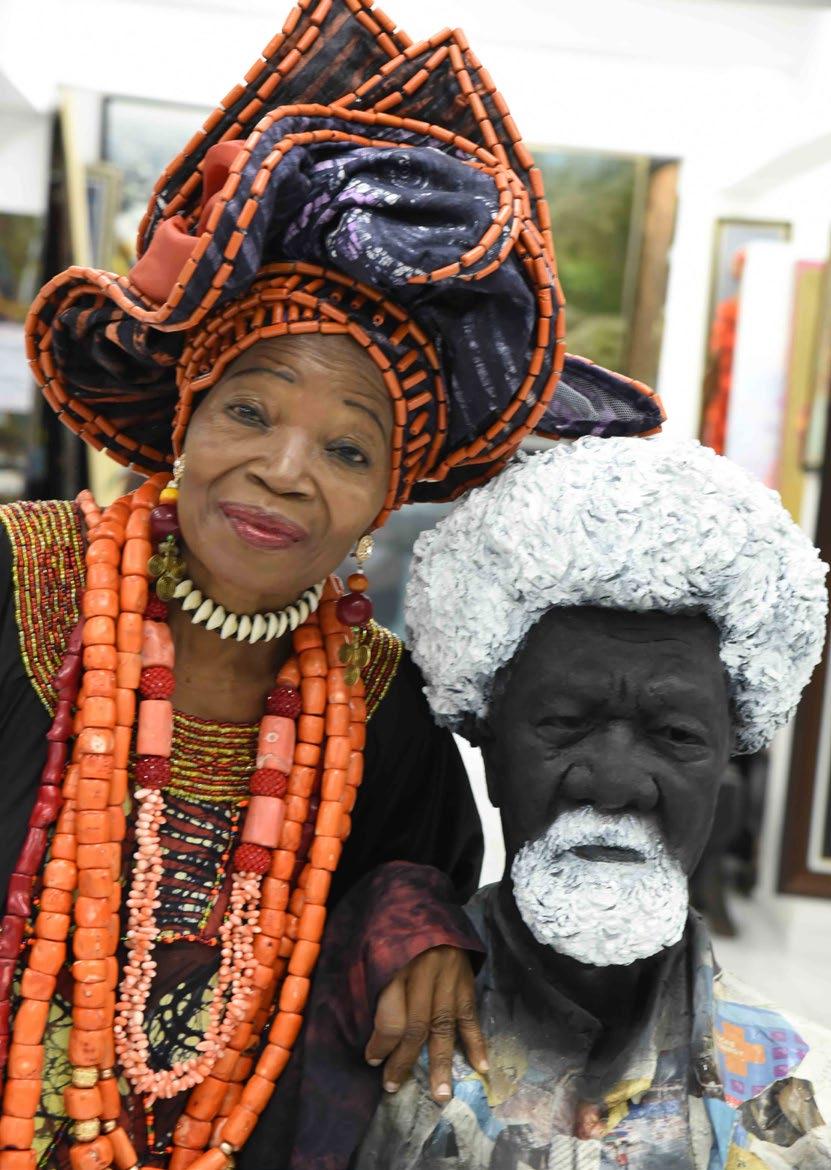


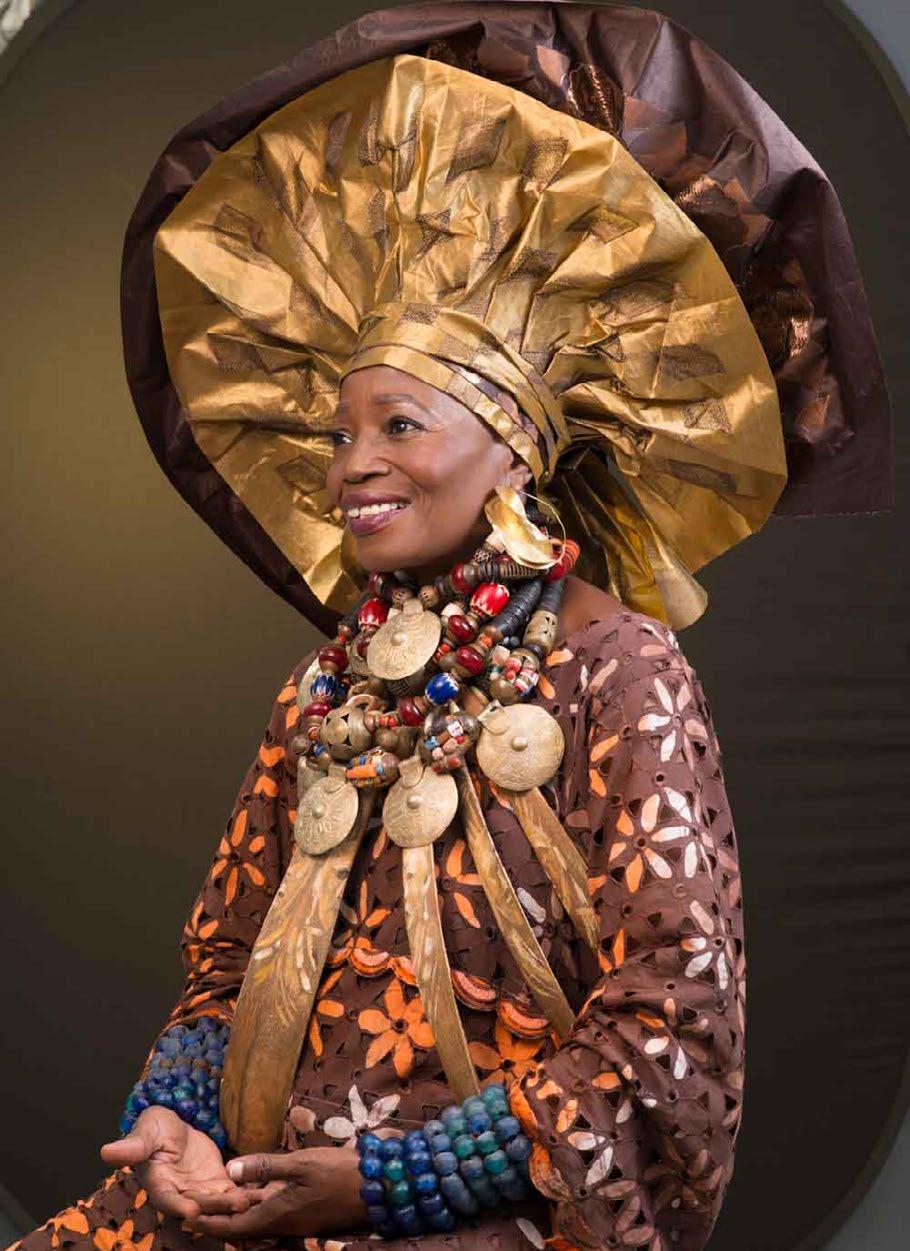

make head-tie giants. It represents my country, Nigeria, to show how we bring ourselves together as a family. No matter what happens, we are our brothers and sisters’ keepers. So, I said, ‘Let’s put all the headties together and make it elaborate.’ Let people love it, and give them something to talk about because sometimes, if they don’t talk about you, the person is dead.’
Why are art and culture important to you?
Nike: Art and culture are important because it is a way of life. Art is like therapy. People don’t know what it can do. Art can save lives and take you to a greater point in the future because you can say this is our oil. Art is life; life is art because when I am working, I work with my soul. I put my spirit into my work.
VOL 3 NO. 15 • APRIL 09 - APRIL 15, 2023 PAGE 10 COVER
EASTER
Beauty Egg
BY DEBBIE ODENIYI
Easter season is finally here! Whilst it’s not typical to go all out with beauty trends, we say it’s also the perfect opportunity to, so get creative this season. From flushed, dewy looks to holographic eyeshadows and bold eyes, the list is endless. Here are some makeup trends to try this Easter.
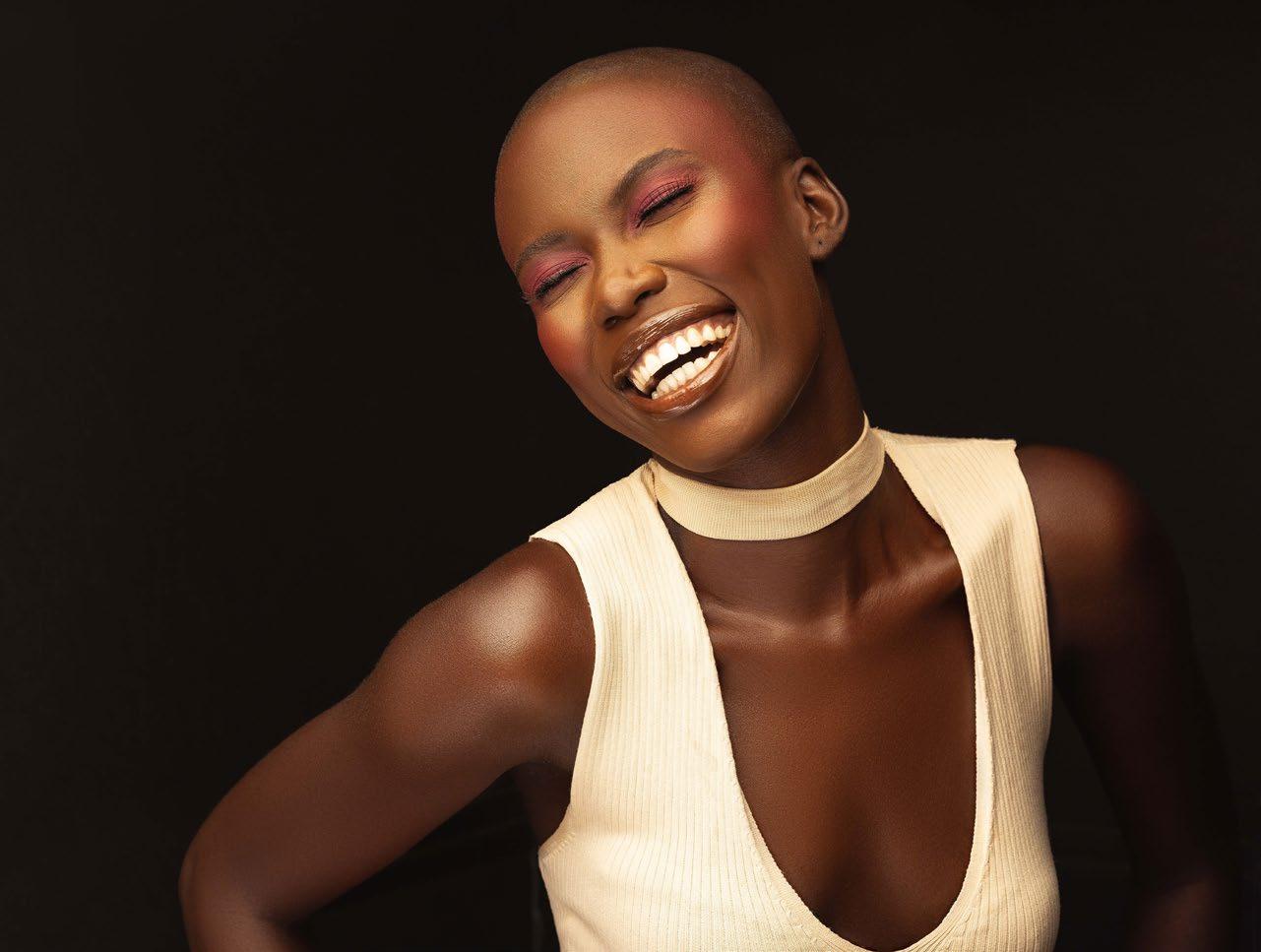
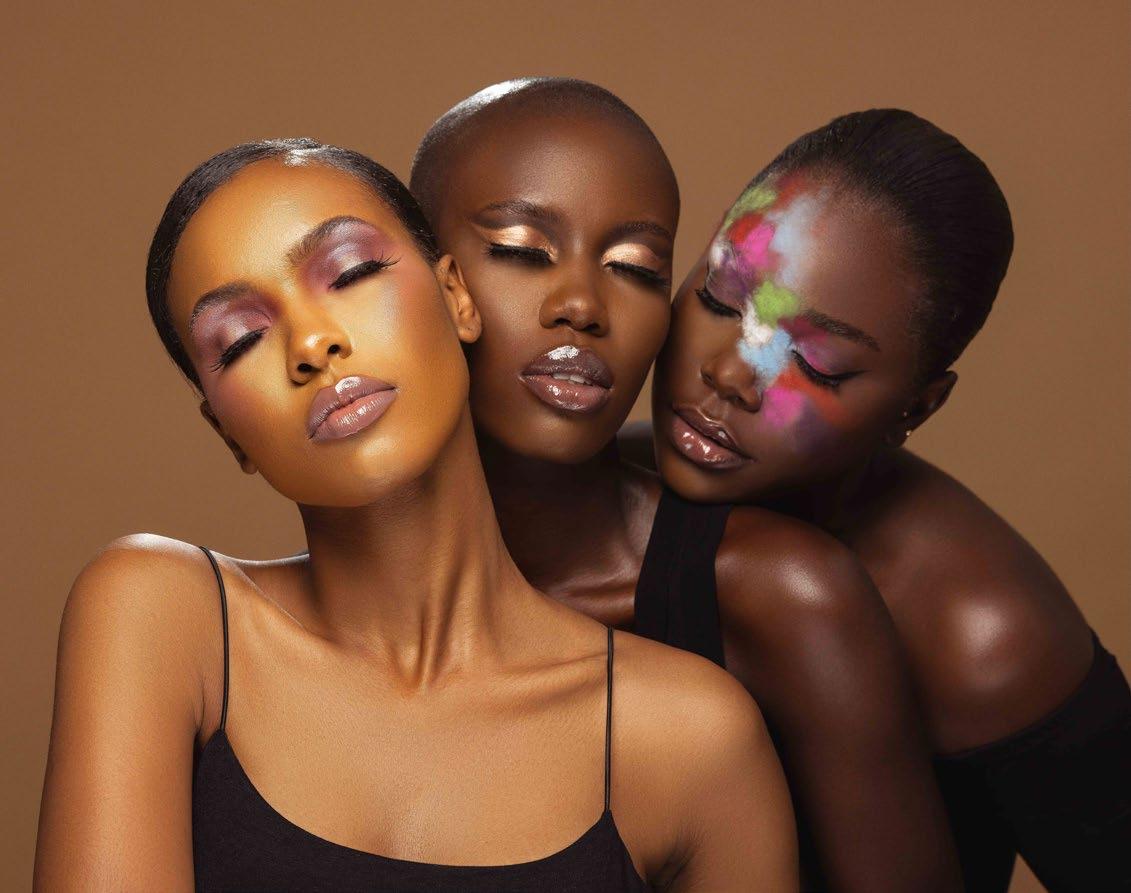


1 2
ACCENTUATED LASHES
3
SULTRY CHEEKS
Eyes have been the in thing for a while, and there’s no sign of backing down anytime soon. Our first top trend is the full, long, black lash look, ideal for all events and screams confidence and boldness. You can achieve this look using Zaron’s newly launched F’Lash Triple Lengthening Mascara. 4
A dewy pop of colour, blended to perfection around your cheeks, is all it takes to elevate your makeup. The Cheeky Liquid Blush by Zaron should be your go-to for beautiful and soft blush colours.
VIBRANT LIDS
Bold eye colours are fast becoming a favourite go-to. This is mainly achieved using blue, green, pink, and yellow eyeshadows and sometimes going graphic with them. Vibrant lids are especially suitable for parties and hangouts. The Zaron Prime n’ Pop eyeshadow in shade Peacock has all the vibrant colours you need to achieve this look.
HYDRATED LIPS
The supple effect that lipglosses give our lips makes them so important. They not only add shine, but they also help to hydrate and moisturise the lips to keep you looking great all day. The good news is, you can decide to go for clear or nude glosses or switch it up with some coloured glosses too! Zaron offers a variety of colours in the MaxSheen Lip Gloss range.
PAGE 11 THEWILL DOWNTOWN • www.thewilldowntown.com VOL 3 NO. 15 • APRIL 09 - APRIL 15, 2023 BEAUTY
AYURVEDIC BANDWAGON
These Lifestyle Changes Will Surely Improve YOUR BODY, MIND AND SPIRIT
BY KEHINDÉ FAGBULE

When it comes to healing the mind, spirit and body, different people turn to different practices. Ideally, we nurture each facet individually. When we feel a migraine, we turn to medications or speak to a medical doctor. If it is anxiety, we seek a psychotherapist’s help to learn more about our mind and its triggers. To nurture our spirit, we indulge ourselves in several activities such as praying, fasting, yoga or other spiritually fulfilling endeavours. Throughout human history, there are very few 3-in-1 solutions that serve as a holistic healing system for these three facets. Having originated in India over 3000 years ago, Ayurvedic medicine is based on the belief that health and wellness depend on a delicate balance between the mind, body, and spirit. Although its main goal is to promote good health and not fight diseases, treatments may be geared toward specific health problems.
The term Ayurveda is derived from the Sanskrit words ayur (life) and veda (science or knowledge), thus translating to the knowledge of life. Based on the idea that disease is due to an imbalance or stress in a person’s consciousness, Ayurveda encourages certain lifestyle interventions and natural therapies to regain a balance between the body, mind, spirit, and the environment.
Ayurveda treatment starts with an internal purification process, followed by a special diet, herbal remedies, massage therapy, yoga, and meditation. Here are ways you too can embrace the Ayurvedic lifestyle.
VOL 3 NO. 15 • APRIL 09 - APRIL 15, 2023 THEWILL DOWNTOWN • www.thewilldowntown.com WELLNESS
AKWAEKE EMEZI Join The
WELLNESS INTRODUCE A DAILY ROUTINE

The tradition of dinacharya (daily routine) is one of the single most powerful Ayurvedic tools for improving overall health and well-being. Even if you are brand new to Ayurveda, it won’t be long before you hear something about the importance of doing several things—like eating, sleeping, and working—at roughly the same times each day. A daily routine invites health, vitality, and a sense of clarity into our lives. Adopting an appropriate daily routine is undoubtedly one of the most groundings and nurturing things you could do for yourself, and while the concept of having a daily routine is at the heart of an Ayurvedic lifestyle, no single prescription is right for everyone. The general template can and should be adapted to meet the needs of each individual’s constitution and current state of balance. And that’s the beauty of it because the right daily routine can dramatically improve your life.
SELF-MASSAGE EVERYDAY
The act of massage itself melts away tension and stress from the muscles. Usually, when we hear the word, massage, many of us picture a luxurious spa treatment reserved for special occasions. In Ayurveda, however, the practice of abhyanga (Ayurvedic massage with oil) is recommended daily. Fortunately, there is a more accessible alternative to professional massage therapy when it comes to enjoying the nourishing benefits of abhyanga every day—massaging yourself. Oil massage may sound like a messy and complicated process best left to the spa, but once you’ve learned the basics, self-massage with oil starts to become second nature and well worth the effort.

EAT AND DRINK MORE CONSCIOUSLY
Have freshly prepared food: Avoid bread, biscuits, and all other packaged food items. Hot food increases the agni (fire) or metabolic fire on entering the stomach. This in turn sets right the metabolism and enhances appetite and capacity to digest food.

Don’t mix cooked and uncooked foods: As per Ayurveda, mixing cooked and raw foods makes the digestion process complicated. It is easy for our digestive tract to break down cooked food, as the enzymes become activated.


Be mindful of water: According to Ayurveda, water is to be had in between meals and not before or after eating food as it has ill effects. Drinking water immediately before food reduces digestion, while after food is similar to poison, it increases assimilation and causes obesity—it is advised to wait about an hour to drink water after each meal. Warm water consumed in the morning on an empty stomach has a lot of medicinal value. Around two glasses is to be consumed by individuals aged between 18 and 60. Other age groups should consume at least three glasses. This will aid better digestion, better sleep and make you feel more active.
Being well-hydrated is the key to having a glowing complexion. In addition to keeping you young and agile in your youth, sufficient water also helps in keeping wrinkles at bay in your old age as it helps you flush out toxins through urine.

PAGE 13 THEWILL DOWNTOWN • www.thewilldowntown.com VOL 3 NO. 15 • APRIL 09 - APRIL 15, 2023
Eggciting Easter 10
WAYS YOU CAN ENJOY YOUR EASTER EGGS
BY KEHINDÉ FAGBULE
Perhaps
the biggest part of any festivity, food is always a constant whenever we have something worthy of celebration. Especially during religious merrymakings, after fastings and lents have been observed, food is usually plentiful, although specific. Just as Christmas is synonymous with chickens and Eid al-Adha is known for ram meat, Easter celebrations have found a trademark food in eggs. Eggs were a widely used premodern and pre-Christian symbol of fertility and restoration. European “Pagans” (a term used to refer to people who practised a variety of non-Christian traditions) viewed eggs as a symbol of the regeneration that comes with springtime. Early Christians borrowed this image and applied it not to the regeneration of the earth but rather to Jesus Christ. This was also extended to the new life of the faithful followers of Christ.
This Eastertide, from Good Friday to Easter Monday, you can experiment with the eggs with friends and family. There are four basic methods to cook eggs—frying, boiling, scrambling, and baking. Each of these methods has different specific ways or styles. For example, frying an egg can be done in at least five ways. Here are 10 basic ways to cook eggs.

3. HARD-BOILEDUP
A hard-boiled egg is a result of boiling egg for a long period of time. The egg is placed in boiling water and left there to cook for 12 minutes or more. This will result in eggs having hard whites and yolk.
is cooked in a pan with oil or butter. When the side being cooked is done, the egg is flipped to enable the other side to cook for a few seconds.
2. SUNNY-SIDE UP

This style lets only one side of the egg cook. The other side is slightly cooked by the heat below. The yolks are left in their liquid form. It was called “sunny side up” because the appearance of the egg resembles the shape of the sun.


4. SOFT BOILED
Soft-boiled is the opposite of hard-boiled. Using the same boiling method, eggs are placed in boiling water and cooked for a short period of time. The egg white is slightly cooked leaving some parts liquid. It will also produce liquid egg yolks.

VOL 3 NO. 15 • APRIL 09 - APRIL 15, 2023 PAGE 14 THEWILL DOWNTOWN • www.thewilldowntown.com BON APPÉTIT
One side of the egg
5. BASTED
This is similar to sunny-side up. However, instead of leaving the yolks as it was, hot oil from the pan is poured over the egg to let the top cook slightly.


6. OVER-HARD
This is the opposite of over-easy. One side is cooked then flipped to cook the other side. The egg yolk produced from this style is usually solid.
7. POACHED

Poaching eggs means bringing water to a boil. Once the water boils, it is reduced to a simmer. The egg is cracked and placed in simmering water, and cooked until the desired results are achieved.
8. STEAM-BASTED
Steam is used to help cook the egg. Instead of pouring oil over the egg, a little water is added to the pan. The steam produced by the water helps cook the egg.
This is done by baking the egg. Eggs are cracked and placed in an oven-safe cup. Butter is placed on top of the uncooked egg, and then the egg is baked for a certain time.


Scrambled eggs are prepared by whisking eggs in a bowl along with some salt and pepper. The whisked egg is then fried in a pan. This style suggests constant stirring while the egg is starting to cook. As you all know, omelettes are derived from scrambled eggs.

PAGE 15 THEWILL DOWNTOWN • www.thewilldowntown.com VOL 3 NO. 15 • APRIL 09 - APRIL 15, 2023
BON APPÉTIT
9. SHIRRED
10. SCRAMBLED From all of us over at DOWNTOWN, Happy Easter!
BY BOLUWATIFE ADESINA
MOVIE REVIEW:



5 Easter Movies to Watch With The Entire Family
SinceThe Life and Passion of Jesus came out in 1902, there have been literally hundreds of movies about the Easter story of Jesus Christ. There have been big-budget epics like The Greatest Story Ever Told and more personal movies like The Gospel According to St. Matthew Some movies have played fast and loose with the story, like Jesus Christ Superstar. There have been parodies, like Monty Python’s Life of Brian
With these many options, it can be hard to pick a great Jesus movie to watch this Easter season. The following list gives 5 accessible Easter movies about Jesus’ life. The list includes some Biblical epics, some kid-friendly movies, and some thought-provoking movies for adults.
1. The Passion of the Christ (2004)
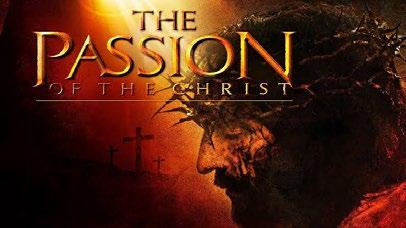
Rating: R

Recommended for Kids: No
Probably the controversial movie on this list, The Passion of the Christ was the highest-grossing R-rated movie released at the time. It’s also credited with proving there was a market for Christian films, which led to movies like Facing the Giants and God’s Not Dead Some Easter movies emphasize Jesus’s otherworldly qualities. Those movies capture Jesus’ divinity but make it hard to believe he ever worried about anything. The Passion of the Christ presents a Jesus (Jim Caviezel under heavy makeup) who looks very Jewish and is first seen crying and trembling in the Garden of Gethsemane.
Rather than moving lightly over the crucifixion to focus on the empty tomb, The Passion of the Christ emphasizes what happened on Good Friday. We get brutal scenes of the pain Jesus went through, from him sweating blood in the garden, to the Roman floggings, to the ordeal on the cross. Satan cameos in several scenes, highlighting the doctrine that Jesus’ death defeated the powers of darkness
Some have questioned whether all this brutality makes the movie sadistic. It certainly makes The Passion of the Christ as iconic as it is, but it’s as close as anyone has gotten to portraying what a crucifixion looks like.
2. The Gospel of John (2003)
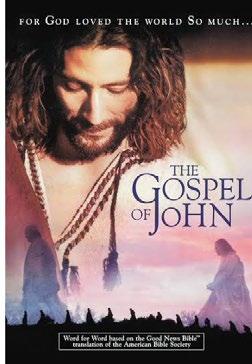

Also marketed as The Visual Bible: John, this 2003 movie follows the same formula as The Visual Bible: Mathew and The Visual Bible: Acts. Each one takes a book of the Bible and presents its text as closely as possible. In this case, the text is the Gospel of John.

At 3 hours long, it’s perhaps best seen in pieces. While it’s not the greatest adaptation of Jesus’ story, the fact it follows the Gospel of John makes it unique. Most movies about Jesus follow the Synoptic Gospels (Matthew, Mark and Luke). Those three gospels share many events, although each has a particular focus (Matthew emphasizes how Jesus fulfilled Messiah prophecies, Mark emphasizes how much Jesus suffered, Luke emphasizes how Jesus brought freedom). Scholars estimate that 90 percent of the Gospel of John is new material, and it seems written for a Gentile audience: John doesn’t start by talking about Jesus as Messiah but as Logos, the Word.

From an adaptation perspective, it’s much easier to base its script on the Synoptic Gospels. Therefore, The Gospel of John is unique because it follows the fourth gospel closely, which makes it a nice pairing with other Easter movies. You can put together a viewing plan to watch a movie based on each of the Gospels, getting a full view of Jesus’ story from the New Testament’s different perspectives.
3. Ben-Hur (1959)
Ben-Hur is a great example of what William R. Telford calls the “Roman-Christian epic”: movies that don’t retell the Gospel story but show its effect through supporting characters. Ben-Hur is by far the best-known of these movies. While its runtime is long and it’s been remade


several times, no one has ever really matched its quality.
The story starts with Jesus’ birth in Bethlehem, then switches to a prosperous young Jew named Judah BenHur growing up in Jerusalem. Betrayed by an old friend, Judah is sold into slavery and has a simple plan: escape and take revenge. When Judah returns to Jerusalem as a free man years later, he finds his old enemy but is surprised to meet someone else: a new teacher travelling about Judea who may be the long-promised Messiah. Since the Romans enslaved Judah, he’s excited that freedom may be coming soon.
The plot provides a little something for everyone—romance, adventure, sports, exotic locations, and melodrama. Judah’s cravings for vengeance against Rome help viewers see what the average Jew expected of the Messiah when Jesus appeared. The fact Judah craves revenge pushes viewers to see how counter-intuitive it feels when Jesus calls us to love our enemies.
While this film isn’t graphic, it’s a bit long for kids to watch. If you want to introduce kids to the story, check out the animated version released in 2003.
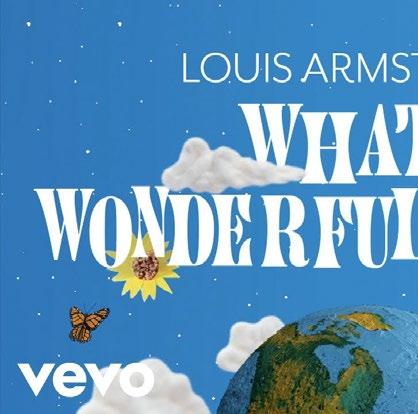
4. The Miracle Maker (2000)



There is a long history of animated movies based on Bible stories. However, they tend to be a bit dry, with a few exceptions like Prince of Egypt. It’s generally easier to adapt a Bible story with some satirical elements (like VeggieTales) than to tell the Bible story straight and risk running into all the clichés.
The Miracle Maker goes beyond what you’d expect. It tells the story of Jesus with claymation figures, cutting to hand-drawn animation for some scenes (what Jesus is describing in his parables, Mary’s flashbacks to finding Jesus in the temple. The story starts with Jairus taking his sickly daughter to a healer who can’t do anything for her. They bump into a carpenter named Jesus (voiced by Ralph Fiennes), who is finishing his last job before going off to do his “father’s work.” From there, the movie follows Jesus’ ministry from the selecting of the disciples to Jesus’ resurrection, with Jairus and his family reacting to his teaching before and after Jesus heals Jairus’ daughter. Despite a small budget, the animated figures in The Miracle Maker are fluid and lifelike. Like The Wallace and Gromit movies, the camera work looks like something out of a live-action film, making the characters even more engaging.
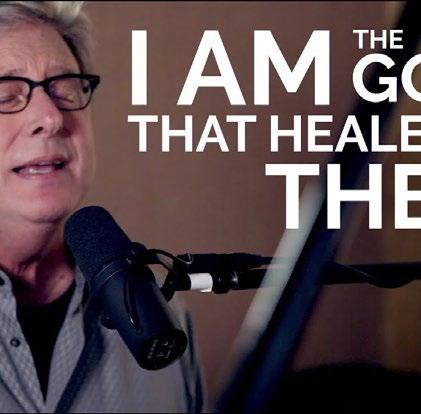
5. King of Kings (1961)
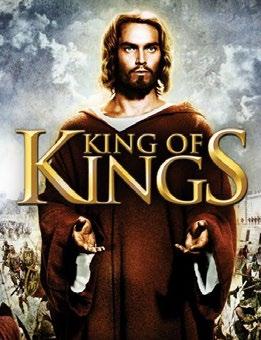
Dozens of Biblical epics appeared in the 1950s-1960s, but most haven’t aged well. The acting seems campy, the costumes artificial (“Bathrobe epics” as some call them). The runtimes are so long these movies make the extended Lord of the Rings trilogy feel like a quick romp. King of Kings is that rare Biblical epic that has aged well.. Like pretty much every epic, it embellishes the story—it starts with the Romans invading Jerusalem in 63 BC. It features a Roman soldier who keeps meeting Jesus and finally says, “surely this man was the son of God '' at Golgotha. These changes give King of Kings a particular focus: what was Jesus’ message in a violent time? The Romans and Herod Antipas wanted Judea as a peaceful colony. The Israelites wanted to overthrow their rulers. Jesus declared he was the prophesied king, but his kingdom was not what they expected.

VOL 3 NO. 15 • APRIL 09 - APRIL 15, 2023
Scan this with your camera to access the playlist (Apple Music) Scan this with your camera to access the playlist (Spotify)
Andrea Bocelli - Gloria In Excelsis Deo (Angels We Have Heard On High)
Louis Armstrong - What A Wonderful World
Elevation Worship - Then He Rose
Benjamin Dube - Bow Down_Holy Spirit
Weyes Blood - Andromeda
Kacey Musgraves - Oh, What A World
Emily Rubye - Next
Don Moen - I Am the God That Healeth Thee
Don Williams - Lord, I Hope This Day Is Good - Single Version
THEWILL DOWNTOWN • www.thewilldowntown.com PAGE 16
Diana Ross - He Lives in You



















 BY ONWUMERE IKENNA CHURCHILL
BY ONWUMERE IKENNA CHURCHILL








 BY KEHINDÉ FAGBULE
BY KEHINDÉ FAGBULE





















































